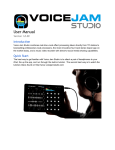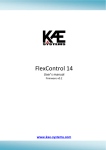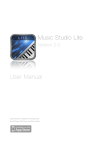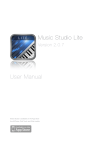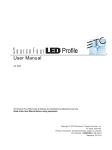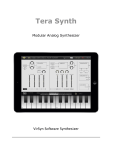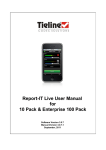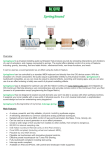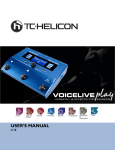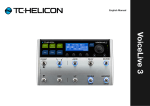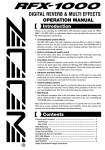Download User Manual
Transcript
User Manual Version 1.5.00 Introduction Voice Jam Studio combines realtime vocal effect processing taken directly from TCHelicon’s bestselling professional vocal processors, the most innovative four track stereo looper app on the market today, and a music video recorder with directtosocial media sharing capabilities. Quick Start The best way to get familiar with Voice Jam Studio is to attach a pair of headphones, fire up the app, and run through the builtin tutorial. The second best way is to watch the tutorial videos found on http://www.voicejamstudio.com Contents Introduction Quick Start Contents Making Connections Connection Options Headphones with the builtin Mic Headset (Headphones with integrated mic) Mic/Instrument Adapter Device with ⅛” Connector Lightning Enabled Audio Device TCHelicon Product with USB Audio Support via Camera Connection Kit USB Sound Cards via Apple Camera Connection Kit Setting Levels The Controls Vocal Effects Preset Favorites Vocal Effect List Spatial Simulation Subtle Chromatic Pitch Correction Extreme Pitch Correction Doubling Distortion Echos Extreme Shifting Special Effects Looping What is Looping? Metronome Loop Action Synchronization Creating Loops Destroying Loops Starting and Stopping Loops Overdubbing Loops Overdub Sessions Waveform Touch Modes Undo/Redo Scrub (Tape Stretch) Stutter Reverse Loop Sync Modes Beat Sync Loop Sync Serial Free Time and Pitch Manipulation Mixer Sessions The Default Session Performance Recorder Performance Library Managing Past Performances Performance Detail Editing App Settings Slave To External Tempo Overdub Decay Knob Automation Time Record Count In Audio Latency Performance Recording Stop Audio When In the Background MIDI Sync Syncing to an App Syncing to external MIDI AudioBus Basic Connection Routing external apps through the metronome track Loop Transfer: Audio Copy Send and receive loops from iTunes App Documents Making Connections Voice Jam Studio is a realtime vocal effects processor, meaning you hear the results of the effect algorithms applied to your voice as you are singing with almost no perceptible delay (refer to the latency section for more information). This presents an incredibly liberating experience for singers. Singing through live effects in realtime is like playing a new musical instrument. Caution: When singing through low latency professional music processors, whether it be on stage or in the studio, one has to be careful to avoid creating audio feedback loops. A feedback loop occurs when the sound coming into a microphone is amplified out through speakers and is picked up again in the same microphone, which goes back through the speakers again and again. This often creates a highpitched squealing sound. Feedback can be avoided by reducing the gain or by making sure the microphone is pointed away from the speakers. Note: All iPhones & iPads have a builtin microphone and speakers. At minimum, Voice Jam Studio should be used with a pair of headphones in combination with the builtin microphone. Voice Jam Studio automatically prevents your live voice from passing directly through to the internal speakers as the metal shell of the device would start vibrating and would feed back into the internal microphone causing a feedback loop. C onnection Options Headphones with the built-in Mic The simplest option. Make sure you don’t cover up the microphone port with your finger. Attach any set of compatible headphones (earbud, overtheear, etc.) to the ⅛” headphone port. Headset (Headphones with integrated mic) Connect a headset with a builtin microphone to the ⅛” port audio port. Your device’s internal microphone will automatically be disabled. Mic/Instrument Adapter Device with ⅛” Connector There are devices on the market which make it possible to connect an XLR microphone with a headphone adapter through the ⅛” port. This setup is similar to using a headset. Some devices provide an output to a PA system instead of headphones. In this case there is always the possibility of audio feedback if the speakers are pointing at the microphone. Lightning Enabled Audio Device Modern audiointerfaces (external hardware devices) connect directly through the lightning port and can provide multiple input and output channels from the audiointerface to your device. Sound quality with these types of devices is generally much higher than using the ⅛” jack. The common configuration of these devices is to have a microphone going to the first input (mono vocal channel) and an instrument like a guitar going to the second input channel (mono input channel). Voice Jam Studio will feed the vocal channel through the vocal effects path and into the looper. Note: It’s also possible to record more instrument channels into your performances. See the AudioBus section for more information. TC-Helicon Product with USB Audio Support via Camera Connection Kit Many of TCHelicon’s worldclass vocal effect processors support USB audio streaming. Any of these products can be connected to your device using Apple’s camera connection kit and a USB cable. Plug your XLR microphone into the TCHelicon device, as well as headphones or a connection to your PA system where applicable. Using TCHelicon products will offer enhanced vocal effect processing. USB Sound Cards via Apple Camera Connection Kit Any USB sound card supported by Apple can be connected via the camera connection kit. Voice Jam Studio will take the first channel and send it through the vocal effects and into the looper. Note: It’s also possible to record more instrument channels into your performances. See the AudioBus section for more information. Setting Levels No matter what connection method you use to get audio into Voice Jam Studio, it’s important that it receives the ideal signal level. Depending on the device you are using, there may be a microphone sensitivity control, or an input level control. Adjusting this level in combination with controlling your distance from the microphone and how loudly you sing will enable you to find the perfect input level for optimum sound quality. While you are singing, the level meters in the top right corner of Voice Jam Studio’s interface should be constantly rising to show green, often yellow, sometimes orange, but never red. If the level meters only show blue, you don't have enough input level for the vocal effects to sound their best. Bars rising on the left indicate lower frequencies while bars to the right show higher frequencies. The Controls Before we get into detail, take a quick glance at the layout of the user interface. It’s worth skimming through the brief descriptions of each of the controls. Refer back to them when reading through subsequent sections. Vocal Effects The name at the top left (between the left and right arrows) describes the current vocal effect. “Dry” means no effect and is useful in situations where you are speaking to the audience or where you want to rely 100% on the natural sound of your voice. In Dry mode the “Note Hold” and “Pitch Bender” controls have no effect as Dry operates as a “true bypass” in the sense that no effect processing occurs. Voice Jam Studio offers many different vocal effects. You can step through them one by one using the left and right arrows. You can tap on the vocal effect name to see the complete list which you can scroll through. You can try out each effect by touching the name of the effect and singing through the microphone. To scroll through the list touch and drag the list with your finger up or down. Double tapping on an effect name selects and collapses the effect list, or you can tap the preset name at the top to collapse the list. Preset Favorites You can instantly recall your favorite 5 presets (A, B, C, D & E) by tapping on the blue circles when the preset list is dropped down. To store a favourite, select it in the list and then hold one of the blue circles for 2 seconds, just as you would store a radio station in your car. Vocal Effect List Spatial Simulation Dry Bright Room Reverb Ballad Reverb Super Bright Subtle Chromatic Pitch Correction Pitch Assist Pitch Assist Room Pitch Assist Hall Extreme Pitch Correction Hardtune Hardtune Filtered Hardtune Echoes Doubling Stereo Wide Double Room Double You Double Hall Thick Chorus Deep Double High Double Deep Double Wide High Double Wide Distortion Attention Shoppers! Megaphone Distorted Distorted Megaphone Echos Echo Echo Rockabilly Slap Dotted Eighth Echo Runaway Echo Psychedelic Echoes Echoverb Extreme Shifting Popeye Olive Oil Deep Voice Deeper Voice Deep Detune Female to Male Male to Female Thicker Thinner Deep C Fixed Major Harmony Church Monks Special Effects Cylon Rotary Speaker Falling 4ever Synth Bass Drum 60's Sci Fi Flanger Talkin' Tube Bass Distort Sing Guitar Solo Looping What is Looping? All music is layered. For example, a band has various members, each adding something to the fabric of their music, while a solo artist often relies on a guitar or keyboard to accompany their singing. Loopers offer an innovative alternative for layering and augmenting the music making process. A looper takes advantage of the cyclical nature of all popular music by first allowing you to record a small chunk of audio (usually 4 to 16 beats) and then plays it back in a repeating loop. As the loop repeats, you can overdub and continuously layer new sound on top of it each pass. The realtime and nonstop nature of loopers make them instruments in their own right and have become essential in today’s music industry. Every fiber of the design of Voice Jam Studio is based on the notion that to loop is to perform. Voice Jam Studio is an instrument. Through an innovative set of industryfirst looping features, Voice Jam Studio allows you to break through the boundaries of monotonous single bar looping to create compelling fully expressed performances. Metronome The easiest way to create great loops is to construct them around an existing groove. Before you record your first loop, you’ll want to establish your session tempo. The metronome lets you specify a tempo by either tapping a rhythm directly on the BPM indicator text, or by tapping the left and right metronome arrows to increment or decrement the tempo by 0.5 BPM in either direction. Optionally you can sync to an external MIDI tempo by using Apple’s Virtual MIDI system. Refer to the Virtual MIDI section for more details. Voice Jam Studio has several built in Metronome Sounds, as well as a muted mode where the metronome beats can be seen visually by a flashing light bulb icon. Touch the pulsating metronome icon to select from the various metronome sounds. Note: it’s possible to use an external drum machine via AudioBus to replace the builtin metronome sound. Refer to the AudioBus section for more details. Note: Once you’ve recorded at least one loop at a given tempo, the tempo of the session becomes locked so that loops can be synchronized to each other for the remainder of the session. To select a new tempo simply erase all of the loops. Besides selecting the Mute mode for the metronome sound, the metronome is also temporarily muted when you touch All Stop. Keep pressing All Stop and you can toggle the metronome On and Off. The metronome also unmutes when you touch All Start. The level and stereo panning of the metronome can be edited from the Mixer controls. It can also be filtered through a lowpass filter. Refer to the Mixer section for more details. Loop Action Synchronization Once a metronome beat is established, it’s important to understand how all looping actions including creating, starting, and stopping loops are synchronized/quantized to the beats. Any time you initiate an action, Voice Jam Studio determines whether you are closer to the beat that just happened (if you press slightly late), or if a beat is about to occur (you press slightly early). If you press early, the event won’t take place until the imminent beat occurs. If you press just slightly late, Voice Jam Studio will make an intelligent decision based on the situation. In general it’s better to be slightly early as if you are slightly late the looper may have to fade in the beginning of your loop to keep it on time missing any transient you might have had to start the loop. Also if you are too late, Voice Jam Studio may decide that you are intending to start on the next beat which might throw your entire loop off by one beat (of course this could lead to an interesting musical effect!) Creating Loops Voice Jam Studio doesn’t place limits on when you can start recording a loop. The process of creating a new loop requires two touches. The first touch to the record icon begins the loop recording (synchronized to the closest beat), and the second touch to the record icon “closes the loop”. The time between the two touches dictates the length of the loop. If you capture four complete beats the loop will be exactly four beats long. After pressing the record button the second time the loop will begin to repeat until you stop it. Note: the most common loop is a multiple of 4 beats. If you want to record a 4 beat loop you would touch record at the beginning of beat 1 and at the end of beat 4 (actually the start of beat 5). You want to capture four complete beats. If you pressed the record for the second time at the beginning of beat four you would have only captured three complete beats. There are two alternate methods of closing, or “setting” a loop. Instead of pressing the record icon for the second time, you can set the loop by pressing the play button or the stop button. The stop button will set the loop and stop it from playing back until you again press the play button. The play button will set the loop but keep it in “record mode” or overdubbing, such that you can immediately begin to layer on top of it as it repeats. Note: once you create at least one loop you will see a lock icon appear beside the metronome BPM. This indicates that the tempo is locked. See the metronome section for more details. Destroying Loops To prevent accidentally erasing a loop, you simply have to hold your finger on any of the ‘X’ icons for a short time. You’ll see an orange halo shrink to nothing before the erase occurs. This gives you a splitsecond to change your mind. Destroying loops is final, unless you’ve saved your session in which case as long as you don’t save again, you can always reload the current session. See the Sessions section for more information. Starting and Stopping Loops Each loop has an individual stop and play button. At the bottom there is also “All Start” and “All Stop”. They start and stop all existing loops simultaneously, as well as mute and unmute the metronome. Note: If you want to unmute the metronome without starting all loops you can tap the metronome icon. Overdubbing Loops To overdub means to layer on top of a loop track. While Voice Jam Studio allows you to record and play loops on 4 separate tracks simultaneously, it also allows you to add unlimited layers onto each loop. For example you could record a loop of a simple melody, then on each progressive cycle through the loop you could overdub a new vocal harmony part. You can add as many layers as you want without taking up the other loop tracks. To toggle overdubbing, simply press the record icon on an existing loop. Overdub Sessions Each time you start overdubbing you start a new overdub session. You might notice a grey box containing the old audio data shows up on the left side of the loop waveform. This represents the sound of the loop just prior to starting your new overdub session. You can continue to overdub as long as you want for as many cycles around the loop as you choose during an overdub session. Once you end the overdub session by pressing the record icon again, you can then create a new overdub session, or you can go back into the past by undoing the last overdub session (and everything you layered over however many cycles long your last overdub session was). Voice Jam Studio remembers the last 4 overdub sessions you recorded and you can swipe back and forth between them at will. See Undo/Redo from Waveform Touch Modes below. Waveform Touch Modes There is a control to the right of each loop waveform showing a finger pointing at an icon. This determines the current waveform touch mode for the track. Waveform touch modes can be changed at anytime during your performance. To switch waveform touch modes you hold your finger on the control until a three segment overlay pops up, and you slide your finger towards one of three icons depicting the available modes: Undo/Redo Every time you create a new overdub session, the state of the loop just prior to your new session is frozen in time. Much like an image editor or word processor lets you undo/redo through historical changes, Voice Jam Studio lets you swipe between the last four overdub sessions. You can only swipe through the previous overdub sessions when the Waveform Touch Mode “Undo/Redo” has been selected. Swiping to the right will bring back past overdub sessions and swiping left will move back into the present. For example, you might create an initial loop with a simple melody, start a first overdub session and add a third above harmony, start a second overdub session and add a fifth above harmony, and finally start a third overdub session and add an octave up harmony. At that point you would see 3 grey boxes to the left of the waveform. If you swiped to the right once, the most recent overdub would go away (the octave harmony would be gone) and you would now see one grey box to the right of the waveform and two to the left of it. Swipe to the right again and you would only have the original melody and the 3rd above harmony. Swipe to the left and the 5th harmony returns. Note: You cannot swipe to undo/redo while overdubbing. You must end the current overdub session first. Note: Voice Jam Studio only remembers four sessions, so if you start new overdub session with four existing, the oldest one will fall out of existence. Note: If you swipe to the right to move to older overdub sessions such that grey boxes are showing to the right of the waveform, starting a new overdub session will start a new branch of history and any of the more recent sessions to the right will be lost. From the example above, if you swiped left so that you were only hearing the original melody and the 3rd above, you could start a new overdub session with an octave down and the 5th and octave up sessions would be lost forever. Scrub (Tape Stretch) In scrub mode you can tap or drag your finger directly across the waveform to alter the playback position as if scratching a record. When you let go the groove will be restored because Voice Jam Studio calculates where playback would have been if you hadn’t started to scrub in the first place. Stutter Stutter triggers a rapidfire pattern at the next beat mimicking what you might have heard on several top 40 billboard recordings. Reverse Swipe left to play backwards and right to play forwards. Loop Sync Modes Sync modes determine how loops are synchronized to each other. Each loop can be set to a different sync mode and only loops with matching sync modes will synchronize with each other. Beat Sync All loops set to Beat Sync will have all actions quantized to the nearest beat (create, set, start, stop, odub). This means loops won’t necessarily be synchronized to each other’s boundaries but will always stay in sync with respect to beats. Loop Sync All loops in the Loop Sync group will act on loop boundaries. For example if you recorded a loop and wanted to record a second loop, the recording and setting of the second loop would both occur on the boundaries of the first. This means the second loop will be guaranteed to be a multiple of the first. Serial Only one loop within a serial group can play/record at a time. This is great for building music structure. For example you could start recording on one track and pressing record on the other would set the first and record the second. From then on playing 1 will automatically stop the other (queued to the loop boundaries). It’s really easy to achieve a chorus/verse type structure. Free Most of the time you’ll want all loops to be synchronized with the metronome. The reason you might want to unlock tempo synchronization for a loop is if you'd like to play it rapidly like a sampler, or scrub it, or record a loop that loops to the beat of its own drum. Time and Pitch Manipulation If while singing a sustained note you press and hold the clock icon at the top left, your voice will be frozen in time until you release your finger. It’s a great special effect.The musical note control opens up a vertical slider control that can be used for either gender bending or pitch bending depending on the selected vocal effect. Drag the control higher or lower to adjust the pitch. Some vocal effects snap the pitch back to center like a traditional pitch bend control while others allow you to shift the pitch and keep it there when you let go. Mixer The mixer lets you set level, pan, and filter for each track and for the metronome independently. It's very useful to independently control these parameters during your performance. Turn the filter down to get that electronic lowpass cutoff effect. Increase the “q” to increase resonance in the lowpass filter which accentuates the classic electronic filter effect. You can control the various knobs by holding your finger on them and either moving up and down, or left to right. Tip: Avoid moving diagonally. Up, or Right means turn the knob clockwise, while left or down means turn it counterclockwise. Diagonal movements will not turn the knobs as you would expect. Tip: If you tap on a knob, it will slowly change from where you had it set to Off or PanCentre. Once at Off or PanCentre, tapping it again will slowly change them back. Tapping again while it's moving will cause the automation to complete immediately. You can initiate this type of automation for multiple knobs simultaneously, for example to fade out all tracks at once. You can set the fade out time by going to the settings menu. Note: With AudioBus connected you can route the microphone through the loop tracks and an external app through the metronome track. That way you could use a 3rd party drum machine instead of the builtin metronome sounds. Refer to the section on AudioBus for more details. Sessions Although a looping purist might argue that every performance you give should be “from scratch” with no preexisting material, Voice Jam Studio lets you save your work anyway. When you save a session you are storing the content of all 4 loop tracks plus the state of their four independent undo/redo sessions. Sessions also store the master tempo, the position of all dials in the mixer, whether sync is on or off for each loop, the waveform touch mode for each loop, and of course the active vocal effect. The folder icon at the top allows you to load and save sessions. The Default Session Sometimes you want to start from scratch, or create a new blank session. In that case you should load the default session. Use the file menu, select load, and choose “Load Default Session”. Performance Recorder One of the most exciting things about Voice Jam Studio is that you can record the audio result of everything you do, whether it be singing through live vocal effects, creating, destroying, triggering and retriggering loops, mixing, remixing, filtering and panning playback; the video result of everything the front facing camera captures; and the video screencapture of all the activity you create on the Voice Jam Studio interface. All of that media is seamlessly combined and compressed and prepared for instant upload to Facebook or YouTube or to be exported to your camera roll for processing in your favourite 3rd party app. You can also upload the audio portion of your performances directly to SoundCloud with one click. To operate the performance recorder, first tap the filmprojector icon at the top center of the user interface. Starts and Stops recording Enters the performance library Performance Library Managing Past Performances As long as the library is not empty, you will see a grid of your past performances, their take number and short description. If you want to share or export a past performance, touch it to select it. If you want to delete old performances to save space on your device you can select “Edit” from the top right, touch the performances you’d like to remove, and then press “Delete Selected” at the bottom. Performance Detail Editing Once you select a performance from your library for editing, you can view or share it by clicking on one of the sharing icons. App Settings The gear icon at the top right is where you set global app settings (applying to all sessions). Slave To External Tempo You can chose to slave to external MIDI devices (hardware connected via the camera connection kit, lightning port, or to other apps supporting virtual midi master clock). Overdub Decay When you overdub a new layer onto a loop, you can specify what happens to the underlying layers. If the Overdub Decay was set to 100%, the new layer would be mixed with the old layer and the overall volume of the loop would get louder and louder until it started clipping. Set at around 98% the older layers will gradually fade away such that the overall level remains fairly constant. At 0% the old layers would be completely replaced by the new overdub layer. This is actually a very useful effect if you want to completely replace the contents of a loop without erasing it. You can change the overdub decay in realtime during a performance. Knob Automation Time When you carefully tap a mixer knob without dragging it will initiate loop automation. Automation will gradually change the knob from its current value to zero (or centre pan for pan knobs), or if already at zero, the knob will change to the last value it had been set at before being faded to zero. This allows you to fade in and out by single tapping on the knobs. You can start and stop several knobs simultaneously in this way, for example you could gradually fade out all four knobs at once. The Knob Automation Time specifies how long it takes a knob to automate between the two values. Record Count In If recording a loop when no other loops are playing, the number of beats you select will be “counted in” before recording starts. Audio Latency Low latency is perfect for any performance and is fully compatible when using AudioBus. If you have an older device and you are using lots of CPU intensive 3rd party apps in the background, you may need to set audio latency to High (Slow Devices) to avoid audio clicks due to limited shared CPU resources. The latest and greatest iOS devices generally have no problem managing several audio processing apps simultaneously. Performance Recording If you are shy and you would rather not record the front facing camera video into your performances, you can disable face recording and select “screen only”. You will still end up with a compelling video as your audience will be able to see all screen activity that went into creating your masterpiece. Stop Audio When In the Background When using AudioBus you generally want Voice Jam Studio to stop audio when you move to the background since AudioBus will maintain the streaming connection on its own. The case where you might want it to play in the background is when you are not using AudioBus but you are MIDI syncing to a 3rd party app and you want to switch to that app without Voice Jam Studio stopping. MIDI Sync Syncing to an App One or more apps can communicate together using Apple’s virtual MIDI protocol. Voice Jam Studio can slavesync with any app capable of generating MIDI clock output and capable of following the industry standard MIDI standards when it comes to MIDI syncing behaviours. Open the 3rd party app and select Voice Jam Studio as an output. In Voice Jam Studio settings, enable MIDI sync and select “Virtual Input” as the source. Syncing to external MIDI Voice Jam Studio has been extensively tested with Ableton Live and can slave sync very effectively during performance. Connect your computer via a MIDI connector to a MIDI input exposed by a 3rd party lightning device or USB soundcard or MIDI device connected to the Apple camera connection kit. Direct Ableton Live to output MIDI sync clock to the MIDI device. In Voice Jam Studio settings, enable “Slave to External Tempo” and choose the 3rd party MIDI device. When you start Ableton playing the downbeat will synchronize and you’ll be able to create new loops in sync with ableton. The loops will stay in sync thanks to Voice Jam Studio’s antidrift MIDI sync feature. AudioBus Voice Jam Studio can receive and send audio from and to other apps using AudioBus. For information on how to use AudioBus, visit the AudioBus webpage at www.audiobus.us A third party app may be necessary to get the most out of AudioBus. Basic Connection Voice Jam Studio should generally be on the output with an internal Mic set as the input. This allows you to add third party effects in between. Routing external apps through the metronome track Voice Jam Studio exposes a “backing track” input to AudioBus. Anything connected to it will be routed through the metronome channel. This means you can applying level, pan, and filtering within the app to an external drum machine or sequencer etc. It also means the external sound source will be recorded into your performance recordings. You might want to set the metronome to Mute in this case. Note: iOS devices currently terminates video recording when an app moves into the background. This means that while you are recording a performance take, you must not leave the app to visit other AudioBus apps. You can however control them using the AudioBus slide out control panel if the external apps you are using provide controls. It’s best to configure your external apps before you start recording your take. Loop Transfer: If a loop is empty, click on the waveform touch mode icon to expose the loop import icon just above it. Once a loop has audio in it, the loop import icon will change to a loop export icon. Audio Copy There are times when you are not using AudioBus but you’d still like to transfer your loops to and from external apps. Audio Copy and Audio Paste is a third party standard which many apps work with. From the file menu select “Loop Transfer”. Selecting Audio Copy from a loop will copy its current audio data into an external “clip board”. When you first click Audio Copy you must wait for Voice Jam Studio to export the loop audio. Then you must select “Copy Audio” from the AudioCopy dialog to begin the transfer process. Audio Paste You can only paste to an empty loop. Select the Audio Paste icon and then “AudioPaste From Pasteboard”. Note: if the external loop tempo is not compatible with the current session tempo Voice Jam Studio will do its best to accommodate the conflicting tempo assuming it’s in 4/4 time. Voice Jam Studio will not attempt to time stretch your external loops. Send and receive loops from iTunes App Documents Using iTunes you can access an app’s document folder. If you select “Send to Documents” Voice Jam Studio will export a loop’s audio and create an audio file in the documents folder which you can copy onto your computer using iTunes.




















